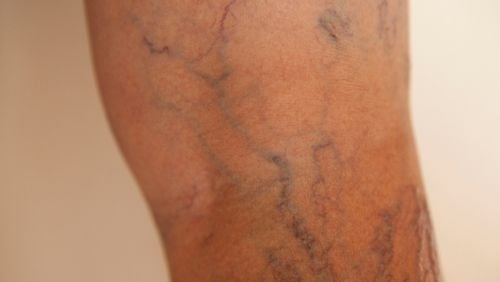Access to this AJC content is brought to you by our sponsor, Wellstar
Have you noticed large, tender veins in your legs? Do you experience aching or swelling in your legs at the end of the day? Do suffer from restless legs? Have you noticed changes in the color or texture of the skin near your ankles?
If you have answered yes to any of these questions, you may have varicose veins or venous insufficiency.
As the heart pumps blood, your body depends on thin-walled veins to return it. In the leg, gravity works against this flow. Muscle contractions of the leg act as a pump, helping this system. Tiny valves in these veins open as blood flows toward your heart, then close to stop blood from flowing back. If these small valves become damaged or weak, blood can flow backward and pool in the vein, causing the veins to stretch or twist, leading to varicose veins.
Some risk factors for varicose veins include age, sex, pregnancy, family history and trauma to the leg. Standing or sitting for an extended period can decrease blood circulation in your legs and increase your risk for developing varicose veins.
Many careers, especially those in health care or factory work, require people to stand on their feet most of the day.
If you notice symptoms, try one or more of these seven tips to improve the health of your legs:
1. Change your position frequently: Moving is better than standing still. Shift your weight often, and stretch or walk around at least every 30 minutes, to keep the blood from settling in your veins.
2. Exercise regularly: Make exercise a priority when not at work. Regular exercise can strengthen your heart and improve your circulation. Walking and yoga are great ways to encourage blood circulation in your legs.
3. Watch your weight: Shedding extra pounds takes pressure off your veins. Losing just 10% of your body weight can make a difference.
4. Watch what you wear: Avoid clothing that is tight around your waist, legs and groin area. Wear low-heeled shoes instead of high heels.
5. Don’t smoke: If you do, quit. Being smoke-free is good for your veins and overall health.
6. Wear compression stockings: You can purchase compression stockings at most medical supply stores. Be sure to speak with your health care provider or pharmacist before you purchase stockings, as your legs should be measured for proper fit.
7. Elevate your legs: Before or after work, raise your legs above your heart for 15 minutes.
There are minimally invasive treatment options if your varicose veins do not respond to these tips. In the past, people with varicose veins were treated with vein stripping, a surgical procedure that produced long scars. Today’s treatment options produce good results, both cosmetic and symptomatic, with little downtime and scarring.
Radiofrequency or laser ablation uses heat or light to damage the vein and cause it to collapse and fade. Another option is sclerotherapy, which injects a solution through a small incision at in the ankle to cause the vein to collapse. After either procedure, most people can return to work the next day and see full results in two months.
For more content like this, sign up for the Pulse newsletter here.
Dr. Jared Slater is a general surgeon in Mankato and New Prague, Minnesota.
About the Author

